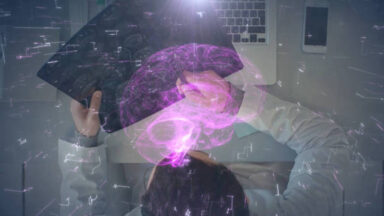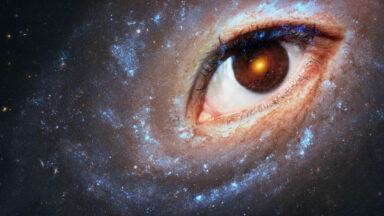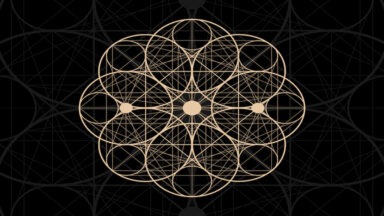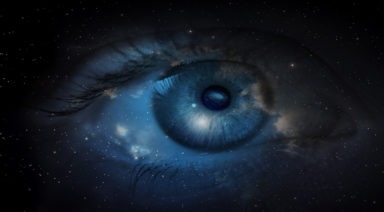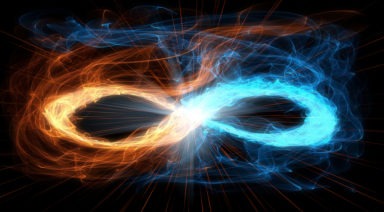What is the Multiverse?

As our understanding of science grows, our self-importance, or rather the importance of humanity, shrinks. The immensity of the universe is continually expanding. In Ancient Greece, Aristarchus was the first to suggest that the Sun was the center of our solar system, not the Earth, and that it was five times bigger than Earth. Many centuries later, Galileo used a telescope to observe the planet Jupiter and its moons, greatly expanding the size of the known solar system. The philosopher, mathematician, Dominican friar and poet, Giordano Bruno, also challenged the geocentric view and argued that the universe was infinite, containing many other Suns and planets, perhaps with unique lifeforms.
The Expansion of Human Knowledge: From Copernicus to Freud
The astronomer Copernicus resurrected the Heliocentric idea, that the Earth is one of many planets orbiting the sun, but even he underestimated the size of the solar system by about twenty times. It’s worth pointing out that, several hundred years ago, these ideas were not popular with the reigning authorities and both Bruno and Galileo ran into trouble with the Roman Inquisition. Bruno was burnt at the stake, though the Vatican today claims it was for his religious, not his astronomical ideas; Galileo was put under a lengthy house arrest. Copernicus delayed his publications to avoid these same fates.
In the 19th Century, Charles Darwin proposed that humans evolved from other animals on Earth, and were not distinct from them. Humans became just another mammal, descended from a long lineage of mammals and their ancestors. In psychology, Sigmund Freud suggested that our conscious minds weren’t the sole source of our feelings and actions, and that deeper unconscious motivations, that we aren’t even aware of, make us who we are.
Schrödinger Drops a Sub-Atomic Bomb in Quantum Mechanics
Then along came quantum mechanics at the beginning of the 20th Century which suggested that matter is, in fact, made of tiny sub-atomic particles that behave in ghostly, non-physical ways with their wave-like behavior. They are mostly made of empty space.
So in the course of a few centuries, humans went from being the center of the Universe to inhabiting just one of many planets, in one of many galaxies, being one of many animals and sharing many of their characteristics, and being made of tiny stuff (that is not really solid and more like energetic vapor).
But it didn’t stop there. Quantum mechanics couldn’t quite integrate the reality of sub-atomic particles with the apparent solidity of the world we see around us. Erwin Schrödinger, one of the founders of quantum mechanics, suggested that many possible states of matter and energy exist all at the same time, each in their own separate realities but still somehow next to each other. After all, if particles are really waves, then why does anything appear solid to us? This is known by physicists as the “The Preferred Basis Problem.” If particles exist in a weird “superposition,” as Schrödinger suggested, why are things so defined in our perception? And since we’re made of sub-atomic particles, isn’t each human in a superposition too?
Birth of the Many Worlds Idea
The Copenhagen school of physics, created by Niels Bohr and Werner Heisenberg, came to the view that all quantum Schrödinger wave possibilities are real, but you only see the one you’re measuring or observing at the time. Our perception “collapses” the Wave Function and the other realities disappear. Only the reality being observed is objectively real. So some people call this the “disappearing worlds interpretation,” kind of as a joke. But it’s been the dominant interpretation of quantum mechanics for nearly a century.
Hugh Everett III Writes a New Verse in Quantum Mechanics
In the 1950’s a graduate student at Princeton University by the name of Hugh Everett III came up with a model that attempted to address all these questions. He found the idea of “disappearing worlds” and wave collapse that were prevalent in quantum mechanics both illogical and unsound, mathematically. He didn’t see a special role for the observer in our reality: each reality should stand on its own even if no person or instrument is perceiving it at any particular moment.
What Everett suggested in 1957 was nothing short of radical: all worlds exist and your awareness is “splitting” every nanosecond to perceive one particular point of view that is at resonance with that particular world.
You’re not aware of the other versions, but you’re in many of them. Essentially, you’re everywhere but just conscious of your particular “world branch” at any one moment.
Many physicists were excited by Everett’s approach to objectify quantum mechanics by removing the special role of the observer. However, Everett’s dissertation advisor, the legendary John Wheeler, was concerned that this interpretation, later known as the “Many Worlds Interpretation,” would offend his mentor Niels Bohr, the main proponent of the Copenhagen Interpretation.
A Disappearing Worldview
Wheeler made Everett excise every single reference to branching, splitting or other worlds in his thesis. It was shortened to a mere 37 pages, from the original 100-plus page version and renamed the “The Relative States Theory of Quantum Mechanics.” Everett received his Ph.D. but promptly left physics. The Many Worlds Idea disappeared from view as it was seen as too radical an interpretation and one that was really hard to physically understand, by most physicists at the time.
The Resurrection of Many Worlds
And that’s where it stood for nearly 15 years until another physicist, Bryce DeWitt, asked Everett for the original version of his dissertation (there was one left) and republished it in 1971 as the “Many Worlds Interpretation of Quantum Mechanics.” And for many people, that’s where the original idea of the multiverse comes from. What luck that one particular original copy of Everett’s dissertation survived!
By this time, Everett had become completely disgusted with academia and had totally left physics, working instead for the U.S. Department of Defense in the Weapons Systems Evaluation Group, mathematically modeling nuclear war scenarios. He showed that a nuclear war would be a total catastrophe for all sides, by the way.
His Many Worlds ideas continued to grow and grow. There were even Star Trek episodes on TV about Many Worlds, later known as “Multiverses.” Everett even had a bit of a comeback when he was invited by Wheeler and DeWitt to participate in a seminar on human and computer consciousness at the University of Texas in Austin in 1977. But after that event, he was mostly forgotten in academia until his untimely death a few years later.
Nowadays, the idea that we live in a Multiverse is more popular than ever. And it’s grown beyond physics to cosmology. Those like Max Tegmark at MIT (with the help of fellow cosmologists Alan Guth, Andrei Linde and many others) have written entire books on the topic. Our Mathematical Universe: My Quest for the Ultimate Nature of Reality, for example, features no less than four types of multiverses that we might live in. Not just Everett’s idea of quantum splitting, but also ideas of parallel realities with different universal constants than ours. For example, there could be a universe with a different value for the mathematical constant PI or the PHI ratio, also known as the Golden Mean. Or perhaps our universe goes on forever, with no end.
This is known as “Eternal Inflation,” where universes are still being created! The so-called Big Bang never ended.
In that case there would be infinite versions of our world with only the slightest variation from ours. And you’re there too! Scientists have even calculated how far away you are right now from the next physical version of you (hint: it’s very, very far away.) So there could be other versions of you, both far away in some realities, but close in others.
Many Worlds Versus Many Interacting Worlds
The original version of Everett’s ideas was eventually known as the “Many Worlds Interpretation” (MWI). In this view, the many branches that split into different universes each moment are completely isolated from each other. They never interact again. However, in the last few years, several physicists such as Howard Wiseman, Bill Poirier and others, have created a newer version called the “Many Interacting Worlds” idea (MIW).
This theory accepts the idea of an infinite or near infinite number of parallel realities but instead suggests that they’ve always been here from the beginning of time – and they interact very, very slightly.
The more similar the resonance of those parallel universes, the more there is an interactive, repulsive force between them. And it is these repulsive forces that create what appear to us as quantum effects: things like quantum tunneling, the double slit experiment and quantum entanglement (or what Einstein referred to as “spooky action at a distance”).
In effect, this newer version of the Many Worlds Idea sees the quantum wave function as merely an interference pattern from nearby parallel realities! How cool is that? What we call Quantum Mechanics is nothing more than the combined effect of a multitude of tiny interactions between the multiverse of worlds. In fact, in the MIW model, the behavior of each electron in our world can be explained by its interaction with as few as forty-one parallel realities. How’s that for mathematical precision?
Evidence for the Multiverse
Now here’s the rub: There’s no direct evidence yet that multiverses, of any sort, are real. None whatsoever.
However, there have been proposals for what to look for if they are real. And it’s important to keep in mind that, historically, many ideas that originally seemed weird, like Black Holes at the center of galaxies or Einstein’s General Theory of Relativity, took a long time to get supporting data. Solid evidence proving the existence of Majorana particles, exotic sub-atomic entities that contain both matter and anti-matter, wasn’t found until 2016, seventy-nine years after they were proposed by their namesake.
Dark Energy Constant
Some scientists suggest that the “Dark Energy Constant,” the mysterious force the pushes galaxies apart from one another at ever faster speeds, is evidence that we live in a multiverse. Other versions of our universe might have slightly different values for this number which would change how everything looks and behaves there.
Cosmic Axis of Evil
Then there’s the so-called “Cosmic Axis of Evil,” which is the unexplained directionality of our entire universe that suggests it might have interacted with another universe at some point. Others have suggested that the tiny interactions between universes, so-called “weak coupling,” could be measured by looking at the behavior of ions in highly complex experiments.
Paranormal Phenomena
And my own idea is that all sorts of “paranormal phenomena” that we see from time to time on the planet, from UFO’s to ghosts, to vanishing Bigfoot creatures, even some types of precognitive Remote Viewing, are evidence of our interactions with other worlds or parallel realities.
For instance, what appear to be extraterrestrials and their craft might be occupants of parallel Earths who’ve learned how to navigate the Multiverse. This would make them more Extradimensional entities (EDIs) rather than true ETs. Or they could be ourselves in a future version of Earth just checking up on their past history. As Howard Wiseman, founder of The “Many Interacting Worlds” says, “it’s not part of our theory, but the idea of [human] interactions with other worlds can no longer be ruled out.”
At this point, no one knows for sure. It’s all just informed speculation. But again, keep in mind, as we discussed above, humans once considered themselves to be at the exact center of a universe in which nothing ever changed at all beyond our solar system. Think how far we’ve come from that viewpoint.
How to Use Your Imagination to Explore the Multiverse
Does the idea of a Multiverse seem intimidating or exciting to you? To be truthful many people and scientists feel threatened by it. It’s not easy to consciously understand. I think it’s highly likely that what people call our “imagination” is simply a highly advanced “Multiverse Detector.”
In other words, everything you can see in your mind’s eye may be just another version of our world, each in its own parallel reality.
It’s just as real as what you see around you right at this moment. You can use this to your advantage by deliberating playing around with the different versions of reality that you can see in your mind, knowing that somewhere, in a way we don’t totally yet understand, they are real, physical places just like ours.
Inspiration From the Multiverse
Perhaps in exploring these realities you can get some hints or clues about how to better do the things you are interested in. You could see yourself, in reality, having already accomplished or attained the things you’re focused on in your life. In this way you can make contact with your future self and get some helpful points about what to do next in your life right now. But keep in mind, the main thing is to get a sense of the feeling, vibe or resonance of that world without getting hung up or attached to the specific details. Use those feelings to help inspire you right here, right now.
The Glue of the Multiverse is You
What’s the glue that holds all your Multiverses together? Well, I’d say it’s your personal emotional involvement and levels of excitement in your life. Quite literally, your own vibrations can make their way into other worlds. Don’t overthink this, it’s more something you can feel than analyze. Your physical mind is designed to only handle the reality you’re in right now, so don’t overload it! And to top it off, these Mandela Effect Multiverse theories may suggest that there’s only one big “now” moment: what we call past, present, or future are just different “slices” or perspectives on that one moment. In reality, they’re all happening NOW.
If someone says to you that they’re not experiencing or sensing any other universes you might remind them, as Hugh Everett III did in the 1950’s, that they don’t experience themselves spinning around the Earth’s axis right now either: but they are, at about 1,000 miles per hour.
I’ll admit that imagining your alternate realities may seem a bit odd, but it’s a good type of odd if you use it wisely. You may just discover something surprising about yourself that’s helpful in your life right now.
Ancient Symbols of Protection from Cultures Around the World

Throughout human history, people have searched for ways to safeguard themselves from negative energy, evil spirits, and other forces beyond their control. Across different cultures, ancient symbols of protection emerged to provide guidance, comfort, and spiritual protection. These protection symbols often reflect humanity’s close relationship with nature, the divine, and the mysteries of existence. They have appeared across continents, in various belief systems—from the ancient Egyptians, Greeks, and Celts to Native Americans, Vikings, Pagans, Christians, Jews, and Muslims. Each carries its own story and context, offering not only a symbol of protection against evil forces but also a source of good fortune, positive energy, and well-being in daily life.
If you feel drawn to these powerful protection symbols, it can be overwhelming to understand their origins and meanings. By exploring their cultural contexts and historical significance, you can discover which ancient protection symbols resonate most with you, whether you seek a protective amulet, a talisman, or a sacred sigil to incorporate into your spiritual practice.
Native American Protection Symbols
Native American tribes traditionally embraced ancient symbols of spiritual protection connected to the natural world. Animal totems, for example, represent protective powers derived from the wearer’s guardian spirit. Some of the most common animal symbols include:
- Bear: Represents leadership, physical strength, courage, and the ability to face challenges head-on.
- Crow: Embodies wisdom, intelligence, and keen awareness.
- Eagle: A revered bird symbolizing courage, wisdom, and strength; it also connects the earthly realm to the divine.
- Deer: Offers guidance to safety, gentleness, prosperity, and shelter.
- Gila Monster: Portrays preservation, resilience, and survival.
- Dragonfly: A sign of happiness, speed, and purity, often seen as a symbol of positive transformation.
- Lightning (Thunderbird): Associated with a legendary spirit of power, rain, and renewal.
In addition to animal totems, other Native American symbols provide spiritual protection:
- Arrows: These can signify defense, direction, and the warding off of evil spirits. An arrow pointing to the left often signals protection, while a downward-facing arrow can represent peace. Arrowheads carry protective properties, symbolizing alertness and focus.
- Cacti: Embody warmth, endurance, and maternal love, persisting even in harsh conditions.
- Drums: Used in sacred ceremonies to communicate with the Great Spirit, invoking divine protection.
- Eagle Feathers: Central to rituals and prayer, representing truth and spiritual activation.
- Medicine Bags: Typically made of animal hide and containing items like sage, tobacco, minerals, or a pipe, these bags were believed in ancient times to offer divine protection and good luck, especially in battle.
Ancient Egyptian, Celtic, Christian, and Greek Protection Symbols
Ancient Egypt, Greece, Celtic lands, and early Christian societies also developed significant ancient protection symbols. Within these various cultures, certain motifs recur, bridging continents and belief systems:
- The Cross: While often associated with the Christian faith, the cross also appears in many contexts. The ancient Egyptian symbol known as the ankh signifies eternal life and spiritual reflection. In Greek traditions, a cross represents the four directions and natural balance, much like in Native American symbolism.
- Eyes: In Egyptian culture, the Eye of Horus—an ancient Egyptian symbol resembling the right eye of the falcon god Horus—represents healing, protection, and the harmonizing of masculine and feminine energies. Similarly, the Eye of Ra symbolizes cosmic order and the sun’s protective force. Across cultures, the eye often appears as a symbol of protection—for example, the evil eye, a belief found in the Middle East, the Mediterranean, and beyond. Depictions like the nazar (a blue-eye-shaped amulet) are used to ward off evil forces and bad luck.
- The Hamsa Hand: Originating in the Middle East, North Africa, and regions influenced by Islamic and Jewish mysticism, as well as some Christian sects, the Hamsa hand is a protective amulet. Often used to repel the evil eye, it symbolizes divine guardianship, good fortune, and spiritual resilience. The Hamsa appears prominently in Arabic, Hebrew, and ancient Egyptian contexts, making it a potent emblem of spiritual protection.
- Wreaths: In early Christianity, wreaths represented eternity and the unending circle of life. Some believe displaying a wreath invites the spirit of Christ into the home. In Ancient Rome, wreaths were hung on doors after victorious battles. Today, wreaths can symbolize resilience, continuous growth, and persistent life force amid adversity.
Pagan, Wiccan, Norse, and Occult Protection Symbols
Beyond religious traditions, protection symbols from around the world appear in Pagan, Wiccan, Celtic, and Norse cultures. These symbols often focus on nature, cosmic cycles, and positive energy:
- Labyrinths (Wiccan/Pagan): Walking a labyrinth is a spiritual journey symbolizing wholeness, renewal, and guidance. One cannot get lost in a labyrinth, reflecting the soul’s steady path through life’s challenges.
- Yggdrasil (Norse): This great Viking tree of life connects all realms, symbolizing stability, wisdom, and cosmic order. It serves as an anchor of spiritual protection and unity.
- Powerful Protection Symbols in Norse Traditions:
- The Helm of Awe: A famed Viking symbol for protection, this Icelandic protection symbol (or Icelandic sigil) consists of eight rune-like arms radiating from a center point. It’s believed to protect the wearer from harm and instill fear in enemies.
- Thor’s Hammer (Mjölnir): Another Norse emblem, representing strength, courage, and the safeguarding of humanity. Mjölnir often symbolizes good luck in battles and marriages, as well as blessings for new ventures.
- Wiccan Protection Symbols:
- The Pentagram (Pentacle or Five-Pointed Star): Revered in Wicca, this shape can ward off evil spirits and negative influences. It often reflects the balance of earth, air, fire, water, and spirit.
- Mistletoe: Rooted in Celtic tradition, mistletoe is considered a protector against evil forces, ensuring good luck and prosperity for the community, livestock, and children.
- Runes and Other Amulets: Runes, ancient alphabetic symbols used by Viking and Germanic tribes, can serve as talismans, focusing positive energy and offering guidance. In many belief systems, wearing certain runes or sigils helps ward off negative energies and attract good fortune.









